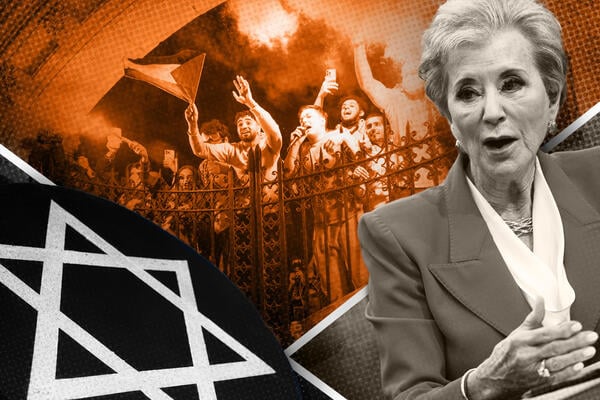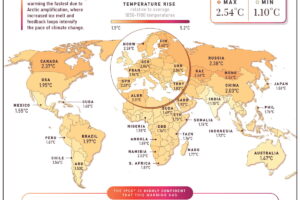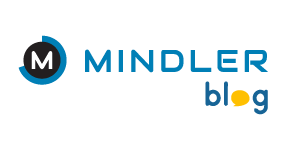
Provosts Agree Antisemitism on Campus Is a Problem
The judge who delivered a legal win to Harvard University in its battle with the Trump administration wrote in her opinion last week, “We must fight against antisemitism, but we equally need to protect our rights, including our right to free speech, and neither goal should nor needs to be sacrificed on the altar of the other.”
It seems most provosts would concur: In Inside Higher Ed’s forthcoming annual survey of College and University Chief Academic Officers with Hanover Research, 88 percent of some 478 respondents agree that antisemitism is a problem in higher education today. But just 20 percent agree that recent federal interventions into campus climates, such as those seen at Harvard and Columbia University—which are unprecedented in scope and speed, and have resulted in the suspension of billions of dollars in unrelated research funding—may be justified.
Pamela Nadell, Patrick Clendenen Chair in Women’s and Gender History at American University and author of the new book Antisemitism, an American Tradition, said, “It’s very important to understand that antisemitism has been a problem on the college campus for a long time, and that most people did not pay attention to it until Oct. 7.” That’s of course when Hamas attacked Israel in 2023, Israel began bombing the Gaza Strip and reports of antisemitic incidents on U.S. college campuses and elsewhere surged.
Nadell continued, “It’s also really important to understand that the leadership of the Republican Party had, well before Oct. 7, been planning an attack on the university.” And there’s “no question, as I see it, that antisemitism has become instrumentalized to do something that the administration and the current leadership has long wanted to achieve.”
Such an approach makes the legitimate problem of antisemitism on college campuses worse, said Beth Gellman-Beer, a civil rights compliance consultant who handled all manner of shared ancestry complaints under Republican and Democratic administrations through the Office for Civil Rights’ Philadelphia branch until it was shuttered in March amid mass layoffs at the Education Department. She described the current set of rapid probes and “kitchen sink”–style demands on respondent institutions as “Trojan horses” that are subject to legal challenges and effectively distract attention from the “critical underlying issue.”
“This administration is hiding the ball, making it even more combative and more difficult,” Gellman-Beer said. “The administration is changing the legal standard with every new letter that comes out. It’s confusing, and it makes senior leaders not necessarily have trust in the process and trust in this administration that what they’re doing is to help the school.”
Sweeping OCR layoffs also neuter the government’s ability to monitor near- and long-term compliance with any agreement conditions that do directly address antisemitism—not only at colleges and universities, but at K–12 schools, she said.
Describing herself as Jewish and the mother of Jewish children who have faced antisemitism since Oct. 7, Gellman-Beer added, “I want nothing more than this to be addressed on campus, but I am devastated by the turn that this administration took.”
Concerns About Antisemitism
With the Trump administration investigating and withholding funds from some institutions over alleged antisemitism, 42 percent of surveyed provosts—the plurality—describe antisemitism as a moderate problem in higher education today, defined in the survey as present and concerning but not pervasive.
Another 33 percent say it is a minor problem, meaning there are occasional incidents or sentiments but it is not widespread or systemic. The remainder are largely split between it being not at all a problem and it being a significant, recurring issue that affects the campus climate and community.
A handful of provosts—1 percent—say it is a severe and widespread problem across higher education.
By sector, provosts at private nonprofit institutions are more likely than their public peers to rate antisemitism a moderate or significant problem, at 63 percent versus 44 percent. Provosts who say they do not work at a liberal arts institution are more likely than their liberal arts peers (n=252) to say that antisemitism is not a problem (18 percent versus 7 percent). Provosts at community colleges are most likely to say it’s not a problem (22 percent), by institution profile.
The survey of provosts was fielded this summer. The full results, on topics from the federal policy environment to artificial intelligence, will be published next week.
Gellman-Beer expressed concern that some of these numbers weren’t higher, given how serious antisemitism is and has become. But she also worried they were proof that the administration’s tack is tainting perception, effectively “backfiring.”
Nadell also expressed concern about mounting antisemitism, which she said ranges from clearly illegal activity to social shunning and other similarly insidious experiences not only for students but for faculty and staff.
Yet she said the survey numbers seem to reflect the reality that recent pro-Palestinian protests, which have been linked to a number of antisemitic incidents, were concentrated at certain kinds of institutions: As one 2024 Washington Monthly analysis co-written by academic Robert Kelchen and based on Pell Grant data concluded, “In the vast majority of cases, campuses that educate students mostly from working-class backgrounds have not had any protest activity.”
Some 19 percent of all Inside Higher Ed–surveyed provosts say their institution saw student protests (over any issue) in the last year. Among community college provosts, this drops to 5 percent. Among public doctoral university provosts, it jumps to 54 percent.
Very few provosts, 7 percent of the sample, say they’ve experienced faculty violations of campus time, manner and place policies for protests in the last year. In a related finding, one in three (32 percent) agrees that faculty members should be discouraged from participating in student-led campus protests.
Speech Climate and Support for Recent Federal Interventions
As is typical in Inside Higher Ed’s stakeholder surveys, provosts take a rosier view of their own institution than others: Some 68 percent rate their own campus climate for civil discourse as good or excellent, but just 16 percent say the same of higher education as a whole. By institution type, private nonprofit doctoral/master’s institution provosts have the highest ratings for their own campus, at 78 percent saying the climate is good or excellent.
By region, provosts in the Northeast are most approving of their campus climate for civil discourse, with 77 percent rating it good or excellent. Those in the West are least approving, at 59 percent.
This year’s results show a slight improvement in provosts’ perception of campus climates and civil discourse over last year. In 2024, 62 percent of provosts rated the climate for open inquiry and dialogue on their own campus highly.
Despite the large share of provosts who rate higher education’s speech climate poorly, just one in five agrees that the kind of recent federal interventions into campus climates seen at Columbia and elsewhere may be warranted. Another 19 percent neither agree nor disagree.
Provosts who say that antisemitism is not a problem, or just a minor one, are less likely than those who view it as a moderate to severe problem to agree that such interventions may be warranted (12 percent versus 23 percent, respectively). But community college provosts—who are especially unlikely to say that antisemitism is a problem—are most open to these kinds of actions, by institution type (28 percent).
The two in five campus leaders who don’t explicitly oppose the Trump administration’s approach to campus speech may feel their institutions aren’t fairly represented by the negative attention post–Oct. 7 protests attracted to higher education as a whole. They may also feel that these kinds of investigations are potent if imperfect means to an end—whether fighting antisemitism or achieving broader change within higher education.
Yeshiva University president Ari Berman, for example, has repeatedly expressed support for the some of the Trump administration’s actions, calling for a bottom-up reckoning for higher education in one interview on Fox Business. “People want to go to a place that is not just safe but actually speaks with conviction,” he said.
Selma Botman, Yeshiva’s provost, said via email that hers is a “privileged institution at this time of heightened sensitivity to the scourge of antisemitism. I can’t speak to what is happening on other campuses, but I can affirm that YU offers a haven for students and faculty who feel unwelcome at other institutions. All campuses have an obligation to maintain academic arenas in which all students and faculty are protected from discrimination and free to exercise their rights as citizens, learners, scholars and researchers.”
Promoting Civil Discourse
The last 12 months have been tumultuous for campus speech in general, and 57 percent of provosts indicate their institution has experienced one or more related issues. About a quarter of provosts each report pressure from donors or alumni regarding institutional positions, internal disputes about appropriate speech policies, and general public criticism of institutional statements or positions.
Twenty percent report legislative oversight or intervention in campus speech matters. This disproportionately affects public institutions, by sector. It rises to 27 percent among all provosts in the South and 26 percent in the Midwest. It falls to 6 percent among provosts in the Northeast (it’s 16 percent in the West).
Asked how well their institution promotes some of the skills associated with positive campus speech environments, two in three provosts say it’s very or extremely effective at promoting critical thinking (64 percent). About half say the same of both free inquiry and free expression. There is more room for improvement around promoting understanding and consensus-building: Some 42 percent say their institution is highly effective at this.
By sector, provosts at private nonprofits are most likely to say their institution excels in promoting critical thinking (72 percent versus 55 percent for public institution peers). On free expression, this is reversed, with 57 percent of public nonprofit provosts saying their institution is highly effective, versus 47 percent of private nonprofit provosts.
Provosts at liberal arts institutions are more likely than those at other institutions to say their college is highly effective in this general area, including in promoting critical thinking (69 percent versus 59 percent).
Leaders’ confidence in their institution’s efforts also varies by region. For example, 41 percent of Midwest provosts rate their institution highly effective in promoting free expression, compared to 64 percent of those in the West. Similarly, 34 percent of Midwest provosts rate their institution as highly effective in promoting understanding and consensus-building, versus 47 percent in the Northeast.
As in last year’s survey, most provosts (75 percent) indicate their institution has taken one or more steps in the last 12 months to educate students, faculty and staff about the importance of civil discourse and to prepare them to engage with those with whom they might disagree. The most common steps taken from a list of options are: offering faculty training on facilitating difficult dialogues/constructive conversations (49 percent), offering staff training on the same (37 percent) and establishing a voluntary difficult dialogues/constructive conversations initiative on campus (35 percent).
Steps such as embedding training on difficult dialogues/constructive conversations into a first-year seminar/program were less cited (20 percent). Mandatory faculty training of this nature is not at all common, at 5 percent.
What would be most helpful to provosts in navigating campus speech challenges going forward? From a separate list of options, respondents are most likely to cite faculty development on teaching controversial topics (40 percent).
About a third of provosts say the following would be helpful: model speech policies that balance multiple interests, examples of effective student programs on civil discourse and/or constructive dialogue, and clear legal guidance on institutional obligations around campus speech.
Fighting Hate—Meaningfully
Lynn Pasquerella, president of the American Association of Colleges and Universities, reiterated that provosts recognizing antisemitism as a problem in higher education today isn’t necessarily “at odds with their disapproval of the tactics used by the Trump administration to punish institutions under the guise of antisemitism.”
Scores of inquiries into colleges by the Education Department under Secretary Linda McMahon and by the Department of Justice are being “launched in ways that bypass procedural norms and weaponize antisemitism,” she said, transforming “what should be a moral priority into a strategic tool for suppressing academic freedom; limiting diversity, equity and inclusion initiatives; and retaliating against colleges and universities insufficiently aligned with the president’s ideological agenda.”
As for more meaningful examples of campus efforts to fight antisemitism, Pasquerella cited American University’s Dialogue Across Differences program and President Jonathan Alger’s campus calls for “radical hospitality,” Rutgers University at New Brunswick’s holistic ScarletWell approach to connection and belonging under Chancellor Francine Conway, Wesleyan University president Michael Roth’s ongoing engagement with religious groups and defense of campus pluralism, and Union Hebrew College president Andre Rehfeld’s public calls for principled leadership that confronts antisemitism by naming and addressing it.
Rehfeld’s enjoinder is, however, “challenged by the increasing number of presidents adopting stances of institutional neutrality,” she added.
Intellectual curiosity and emotional empathy are keys. That’s where education can be at its best, and help tamp down an environment where hate (including antisemitism) might emerge.”
—Kenneth Stern, director of the Bard Center for the Study of Hate
According to the survey, 26 percent of institutions have adopted such neutrality policies. Most of the remainder are not considering adopting one.
Kenneth Stern, director of the Bard Center for the Study of Hate—who’s testified before Congress about antisemitism, describing it, in part, as both based in conspiracies about Jews specifically and a “miner’s canary” for the health of democratic societies in general—said he’s struck by how reports from various campus task forces on antisemitism and anti-Muslim or -Arab or -Palestinian sentiment are “in many ways mirror images of each other.” That is, each “side” feels that administrators may favor the “other.”
To this point, Stern said higher education needs more courses and initiatives on “why we get into those righteous us-versus-them paradigms”—a key focus of hate studies—in the first place. He said Sway, an artificial intelligence–aided debate program profiled by Inside Higher Ed, holds promise for this purpose. Classes on antisemitism, anti-Arab animus and more can also help, he said.
“Intellectual curiosity and emotional empathy are keys,” Stern added via email. “That’s where education can be at its best, and help tamp down an environment where hate (including antisemitism) might emerge.”
Gellman-Beer said previously negotiated OCR agreements with institutions can provide actionable steps for other leaders looking to address antisemitism on their campuses. But these same leaders “need to go speak to their students,” she said, “either through a survey or—what we have seen in some schools, which is very effective—the provost will go sit down at dinner with a group of Jewish students, or a group of Muslim students, and talk to them.”
“Talk to your students,” she emphasized. “What they tell you is going to be much different than what your perception is.”
Nadell said a flurry of revisions to campus speech codes over the summer of 2024 seem to have curbed campus-based antisemitic incidents over the last year, based on Hillel International survey data—but that online antisemitism against students grew over the same period.
As for whether antisemitism is truly worse in higher education than it is in other sectors of society, Nadell said, “We should have a higher expectation,” given the postsecondary mission. Yet colleges and universities “are a reflection of the world we live in. And antisemitism is coming from both the right and the left.”
Source link



